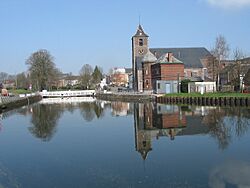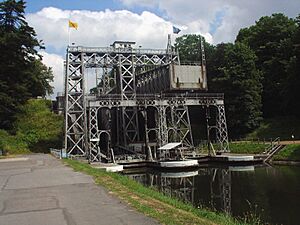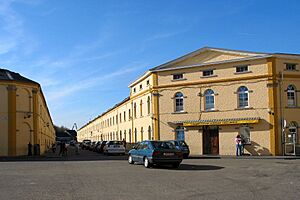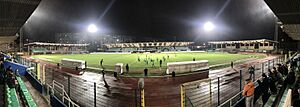La Louvière facts for kids
Quick facts for kids
La Louvière
El Lovire (Walloon)
|
|||
|---|---|---|---|

Houdeng-Aimeries
|
|||
|
|||
| Country | Belgium | ||
| Community | French Community | ||
| Region | Wallonia | ||
| Province | Hainaut | ||
| Arrondissement | La Louvière | ||
| Population
(2018-01-01)Lua error in Module:Wd at line 1575: attempt to index field 'wikibase' (a nil value).
|
|||
| • Total | Lua error in Module:Wd at line 1,575: attempt to index field 'wikibase' (a nil value). | ||
| Postal codes |
7100, 7110
|
||
| Area codes | 064 | ||
| Website | www.lalouviere.be | ||
La Louvière (French pronunciation: [la luvjɛʁ]; Walloon: El Lovire) is a lively city in Belgium. It is located in the Wallonia region, within the province of Hainaut. La Louvière is also a municipality, which means it's a local government area.
This municipality includes several smaller towns and villages. These are Boussoit, Haine-Saint-Paul, Haine-Saint-Pierre, Houdeng-Aimeries, Houdeng-Gœgnies, La Louvière itself, Maurage, Saint-Vaast, Strépy-Bracquegnies, and Trivières. La Louvière is known as the main city of the Centre region. This area was once very important for coal mining. It sits between other historic industrial areas in Belgium.
Contents
History of La Louvière
How La Louvière Got Its Name
There's a cool legend about La Louvière. It talks about a mother wolf taking care of a child. This story reminds people of the old myth about the founding of Rome. But the real history of La Louvière started much later, in the 1100s.
Back then, the area where La Louvière is now was covered in forests. People believed many wolves lived there. So, they called the land Menaulu. This Old French name means "wolf's lair." This land was part of a bigger community called Saint-Vaast. Saint-Vaast belonged to a place called the Aulne Abbey.
By the year 1284, the name of the area changed. It was translated into Latin, then back into French. That's how it got its current name, La Louvière. The lords of Saint-Vaast encouraged people to look for valuable things on their land. This led to the first time coal was dug up there in 1390. However, the abbey didn't build the roads or canals needed to move the coal. So, big mining projects didn't happen until the 1700s.
The City's Fast Growth
In the 1800s, things really changed. New roads, canals, and railways were built. This made it possible to transport the local coal to other places. Many people also invested money in local businesses. They wanted to use the large amount of coal available.
La Louvière quickly grew bigger and richer than Saint-Vaast. Within just 50 years, this small area became one of the most important cities in Wallonia. La Louvière was officially recognized as its own city in 1869. Today, La Louvière is still the fifth largest city in Wallonia. It's smaller than Charleroi, Liège, Namur, and Mons.
Cool Places to See
- Boat Lifts: La Louvière has four special boat lifts on the old Canal du Centre. These lifts help boats move between different water levels. The canal connects the Meuse and Scheldt rivers. These amazing double elevators were built around 1900. UNESCO named them a World Heritage Site in 1998.
- Mining History: You can visit the old homes built for coal workers at Bois-du-Luc. These houses were built in the early 1800s and have been restored. This site is part of the Major Mining Sites of Wallonia. It was also named a World Heritage Site by UNESCO in 2012. You can visit one of the houses and see museums. They show what coal mining was like in the Centre region.
- Old Churches: La Louvière has several old chapels and churches. Some of them date back to the 1200s and 1500s.
- Art Collection: The city also has a great collection of artworks by Idel Ianchelevici. He was a famous artist.
Weather in La Louvière
La Louvière has an oceanic climate. This means it has mild seasons. Even though it's not right by the ocean, the Gulf Stream ocean current affects its weather. This keeps temperatures from getting too extreme.
| Climate data for La Louvière (1981–2010 normals, sunshine 1984–2013) | |||||||||||||
|---|---|---|---|---|---|---|---|---|---|---|---|---|---|
| Month | Jan | Feb | Mar | Apr | May | Jun | Jul | Aug | Sep | Oct | Nov | Dec | Year |
| Mean daily maximum °C (°F) | 5.5 (41.9) |
6.5 (43.7) |
10.2 (50.4) |
14.0 (57.2) |
18.1 (64.6) |
20.7 (69.3) |
23.2 (73.8) |
22.9 (73.2) |
19.2 (66.6) |
14.8 (58.6) |
9.5 (49.1) |
6.0 (42.8) |
14.2 (57.6) |
| Daily mean °C (°F) | 2.9 (37.2) |
3.3 (37.9) |
6.3 (43.3) |
9.1 (48.4) |
13.1 (55.6) |
15.8 (60.4) |
18.1 (64.6) |
17.7 (63.9) |
14.6 (58.3) |
10.9 (51.6) |
6.5 (43.7) |
3.5 (38.3) |
10.1 (50.2) |
| Mean daily minimum °C (°F) | 0.3 (32.5) |
0.1 (32.2) |
2.5 (36.5) |
4.3 (39.7) |
8.2 (46.8) |
11.0 (51.8) |
13.0 (55.4) |
12.6 (54.7) |
10.0 (50.0) |
7.1 (44.8) |
3.5 (38.3) |
1.2 (34.2) |
6.2 (43.2) |
| Average precipitation mm (inches) | 76.8 (3.02) |
63.5 (2.50) |
74.6 (2.94) |
53.5 (2.11) |
72.7 (2.86) |
78.6 (3.09) |
76.3 (3.00) |
80.0 (3.15) |
65.0 (2.56) |
76.7 (3.02) |
77.4 (3.05) |
80.9 (3.19) |
876.0 (34.49) |
| Average precipitation days | 13.2 | 11.4 | 13.4 | 10.4 | 11.9 | 11.4 | 10.5 | 10.7 | 10.9 | 11.4 | 13.4 | 13.4 | 142.1 |
| Mean monthly sunshine hours | 53 | 73 | 118 | 169 | 200 | 194 | 212 | 202 | 145 | 115 | 64 | 44 | 1,588 |
| Source: Royal Meteorological Institute | |||||||||||||
Local Traditions and Festivals
The Carnival in La Louvière is called Laetare. This name comes from a Latin word meaning "to enjoy." The carnival lasts for three days, from Sunday to Tuesday. It happens in the middle of Lent, a time before Easter.
A special group of performers called the Gilles are a big part of the carnival. They are out on all three days. They stomp their feet to music and give out oranges to people watching. Huge puppets and other groups also join the parades and parties. A unique tradition in La Louvière is the Brûlage des Bosses. This means "burning of the humps." A puppet dressed as a Gilles is burned. This symbolizes the end of carnival and the start of new life.
Sports in La Louvière
La Louvière once had a very good football club called RAA Louviéroise. They played in the top Belgian league. In 2003, they even won the Belgian Cup. This club no longer exists. It joined with a team from another city. Now, the old stadium in La Louvière is home to a different, semi-professional team called UR La Louvière Centre.
Famous People from La Louvière
Many talented people have come from La Louvière:
- Maurice Baudoux (1902-1988), a Canadian priest and Archbishop.
- Anna Boch (1848-1936), an impressionist painter and art collector.
- Eugène Boch (1855-1941), an impressionist painter, art collector, and friend of Vincent van Gogh.
- Pol Bury (1922–2005), a famous sculptor.
- Jey Crisfar (born 1988), an actor.
- Clement Desalle (born 1989), a motocross racer.
- Franco Dragone (born 1952), a theatre director.
- Maurice Grevisse (1895–1980), a grammarian (someone who studies grammar).
- Eden Hazard (born 1991), a well-known footballer.
- Thorgan Hazard (born 1993), also a footballer.
- Kylian Hazard (born 1995), another footballer from the Hazard family.
- Jean Louvet (1934–2015), a playwright (someone who writes plays).
- Enzo Scifo (born 1966), a footballer.
- Charline Vanhoenacker (born 1977), a journalist.
Cities La Louvière is Friends With
La Louvière has "twin cities" or "sister cities" around the world. This means they have special friendly relationships:
 France: Saint-Maur-des-Fossés, France
France: Saint-Maur-des-Fossés, France Italy: Foligno, Italy
Italy: Foligno, Italy Spain: Córdoba, Spain
Spain: Córdoba, Spain Slovakia: Bojnice, Slovakia
Slovakia: Bojnice, Slovakia Poland: Kalisz, Poland
Poland: Kalisz, Poland Turkey: Giresun, Turkey
Turkey: Giresun, Turkey
See also
 In Spanish: La Louvière para niños
In Spanish: La Louvière para niños








